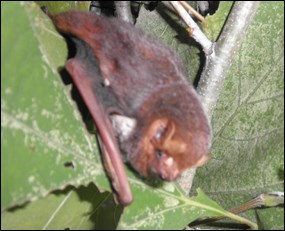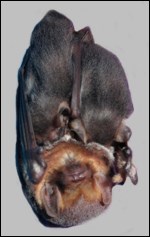
Photo © Hank and Marsha Rhodes The Seminole bat (Lasiurus seminolus) is a medium-sized bat that weighs about 0.3 to 0.5 ounce (8 to 15 grams) and has a wingspan of 11 to 13 inches (28 to 33 centimeters). Seminole bats are sometimes confused with other bat species. Close inspection reveals that the deep mahogany color of their fur is distinctive from the reddish-orange color of eastern red bats. Like hoary bats, the fur of Seminole bats is frosted at the tips, but hoary bats are considerably larger. The Seminole bat is furred to the tip of its tail and its fur extends along its underarms to its wrists, ending with distinctive white patches on the wrists and shoulders that distinguish Seminole bats from Florida yellow bats. 
Photo © Hank and Marsha Rhodes 
NPS photo The Seminole bat is solitary and commonly roosts in pine trees and Spanish moss. The species typically ranges throughout the Gulf Coast states from south Florida to Texas and north to southeastern Oklahoma, southern Arkansas, and the Carolinas. Seminole bats emerge early in the evening year-round when temperatures are above 70 degrees F (21 degrees C) and feed primarily on leafhoppers, flies, beetles, bees, and ants. 
NPS photo Click on the link to the audio file below to hear the echolocation calls of a Seminole bat that were recorded by a bat detector at Pa-hay-okee. Visit the main bat webpage for an explanation of echolocation. The requested video is no longer available.
|
Last updated: February 18, 2025
